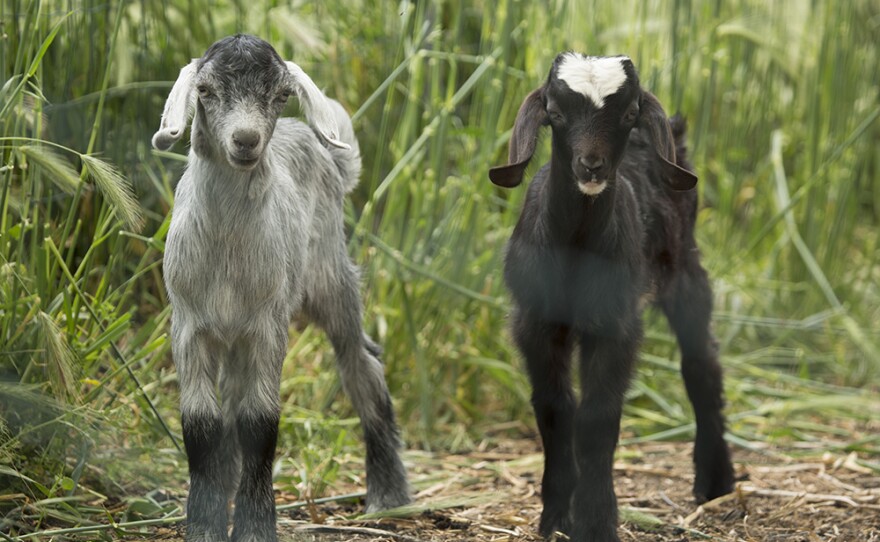Premieres Wednesday, Jan. 5, 2022 at 8 p.m. on KPBS TV + Sunday, Jan. 9 at 8 p.m. on KPBS 2 / On Demand
Our planet is bursting at the seams. Around the world, up to 30 volcanoes erupt every day – and hundreds more could explode at any moment. Meet the people and wildlife that live alongside these volcanoes, from Kilauea to Mount Etna. Discover how volcanoes cause destruction but also create and nurture life.

At the “burning heart” of this documentary is a daring expedition of scientists and adventurers to one of the world’s most dangerous volcanoes, located in the Pacific island nation of Vanuatu. Take a terrifying descent into the Marum Crater with biologist Jeffrey Marlow, who risks a boiling lava lake to collect and analyze rock samples for signs of life. His discoveries could lead to a better understanding of the origins of life and a picture of what life might look like outside of Earth. James Naughton narrates.
Featured Creatures:
- Phytoplankton
- Manta rays
- Wildebeest
- Quito Rocket frogs
- Argentata dell’Etna goats
- Hawaiian carnivorous Eupithecia caterpillars
- Thread-legged bugs
- Galapagos giant tortoise

Noteworthy Facts:
- There are hundreds of active volcanoes on Earth. Each day, up to 30 of these volcanoes are in an eruptive phase.
- Mt. Etna in Italy is one of the world’s largest active volcanoes. Despite the danger, people live nearby since the soil created by Etna’s eruptions produces some of the richest agricultural land in the whole country. Dr. Salvatore Giammanco, an Italian volcanologist, studies the gasses that emit from Mt. Etna and finds that the water vapor levels are extremely high – Mt. Etna releases hundreds of thousands of tons of vapor into the atmosphere every day. This discovery supports a widely-held theory that the first water on Earth emerged not from comets, but from a volcano that tore through the Earth’s crust.
- Kilauea is the most active volcano in the United States—the eruption in 2018 was its most devastating in 200 years, but the volcano is also thought to have provided for life. Following the recent eruption, scientists from the University of Hawaii saw giant phytoplankton blooms in the ocean, which emerged from the enriched lava. Phytoplankton is fed on by larger zooplankton, which in turn becomes food for larger animals such as manta rays.

Buzzworthy Moments:
- One of the most active volcanic hot spots on Earth is the Marum crater of the Ambrym volcano on Vanuatu. Dr. Jeffrey Marlow, a geo-biologist from Harvard University, travels to Marum to search for extremophiles, micro-organisms that can survive in the most extreme environments. Accompanied by expedition specialist Chris Horsley, Dr. Marlow undergoes a perilous journey to descend into the crater and collect samples from the edge of its bubbling lava lake. Risking a 1,300-foot drop, threats of acid rain and extreme temperatures, Dr. Marlow hopes his discoveries could help explain how life may exist elsewhere in the universe.
- A small creek at the base of the Cotopaxi volcano in Ecuador is home to an extremely rare species of frog—the Quito Rocket frog. With only about 100 of these frogs left in the world, their home is on the brink of danger if the volcano were to erupt. A team of scientists, led by Dr. Andres Merino, are frantically collecting the last remaining frogs for a breeding program to help save the species.
- The Argentata dell’Etna is a breed of goat found only on the upper slopes of Mt. Etna. One herder finds that the goats behave erratically shortly before one of Etna’s eruptions. Scientists use GPS tags to corroborate that the goats do indeed move off the mountain before an eruption, but it’s not yet known what triggers their sixth sense.
- Isolated in the Pacific, 90 percent of Hawaii’s native species are found nowhere else on the planet, and the continual disturbance by volcanoes have created a landscape that can fast-track evolution. One resulting example is the carnivorous Eupithecia moth caterpillar. This unusual caterpillar uses camouflage and claws to trick and ambush its prey.

Credits:
NATURE is a production of Thirteen Productions LLC for WNET and PBS. For NATURE, Fred Kaufman is executive producer. Bill Murphy is series producer and Janet Hess is series editor. A production of True to Nature Limited in co-production with ZDF, ZDF Enterprises, ARTE, and Thirteen Productions LLC for WNET. The documentary is produced and directed by Alex Ranken. Wendy Darke is executive producer for True to Nature Ltd. Narrated by James Naughton.







